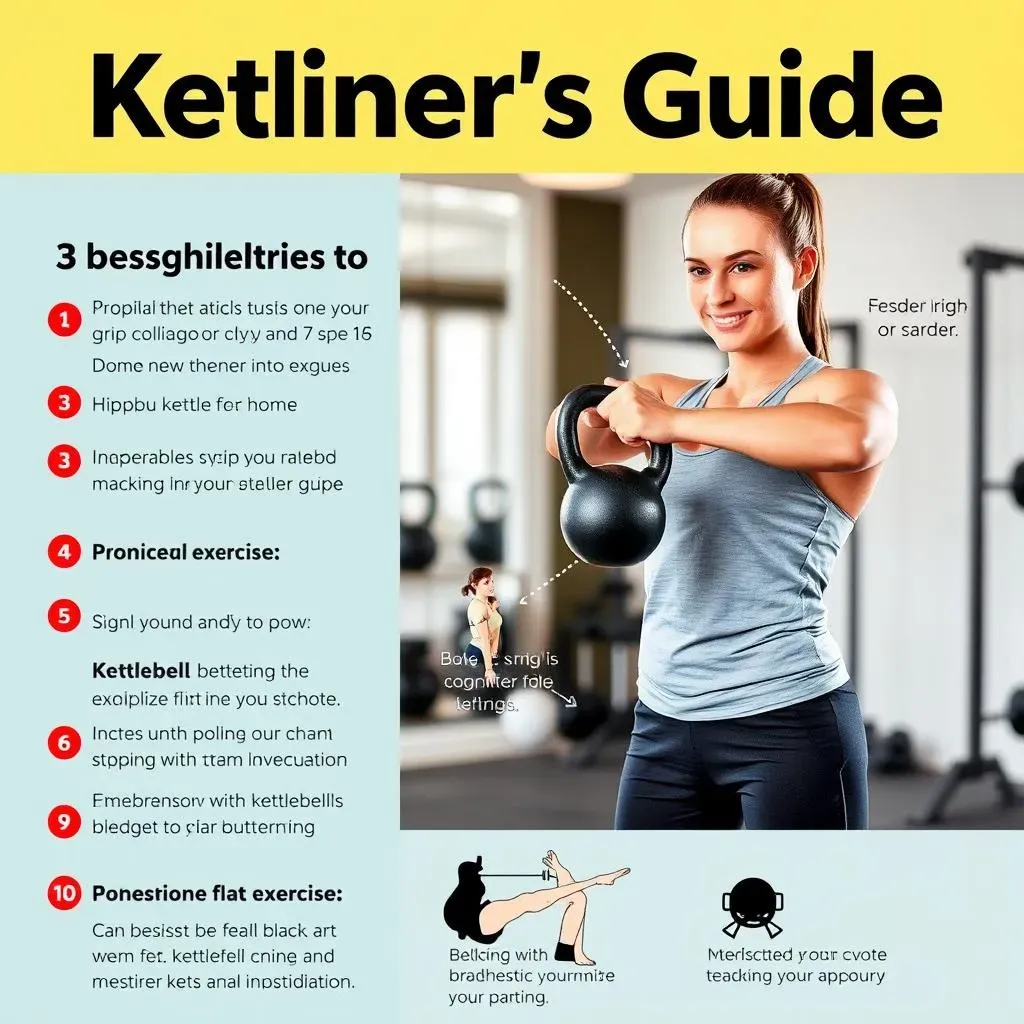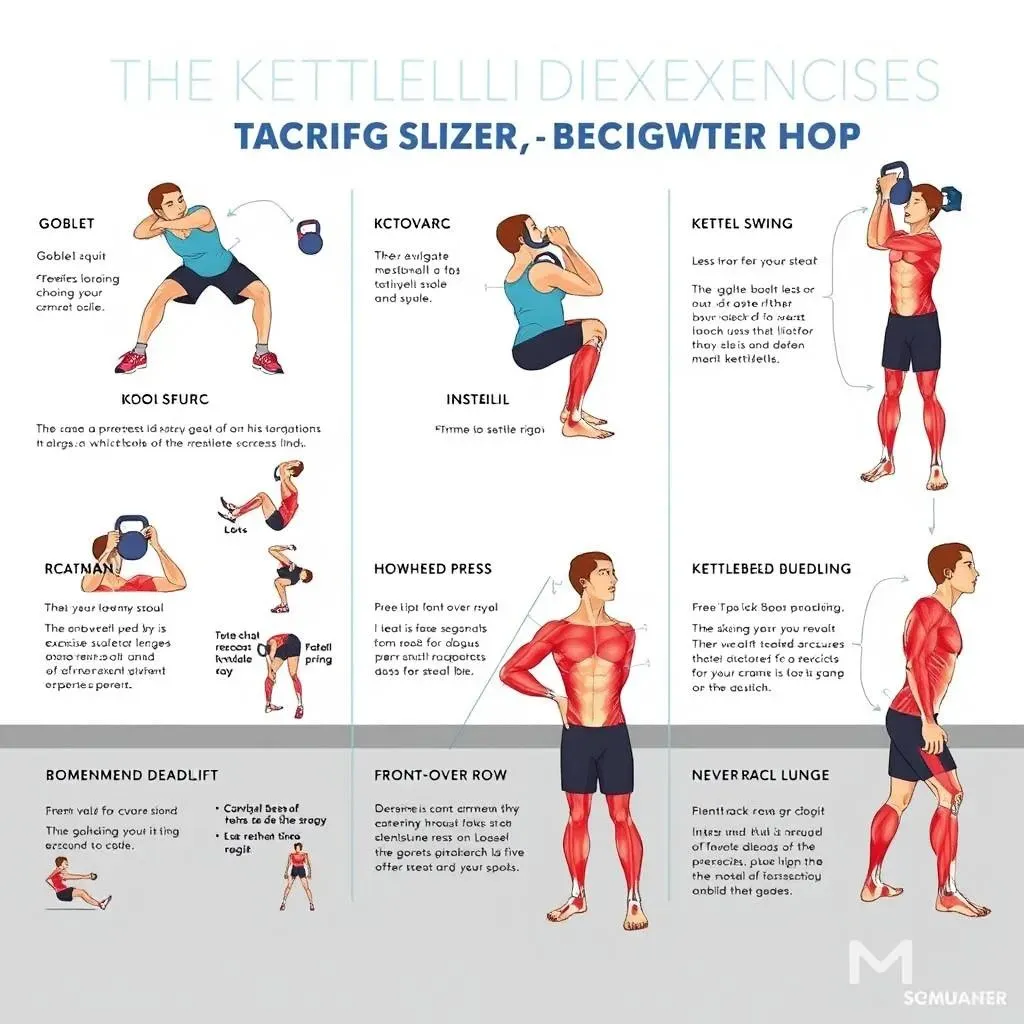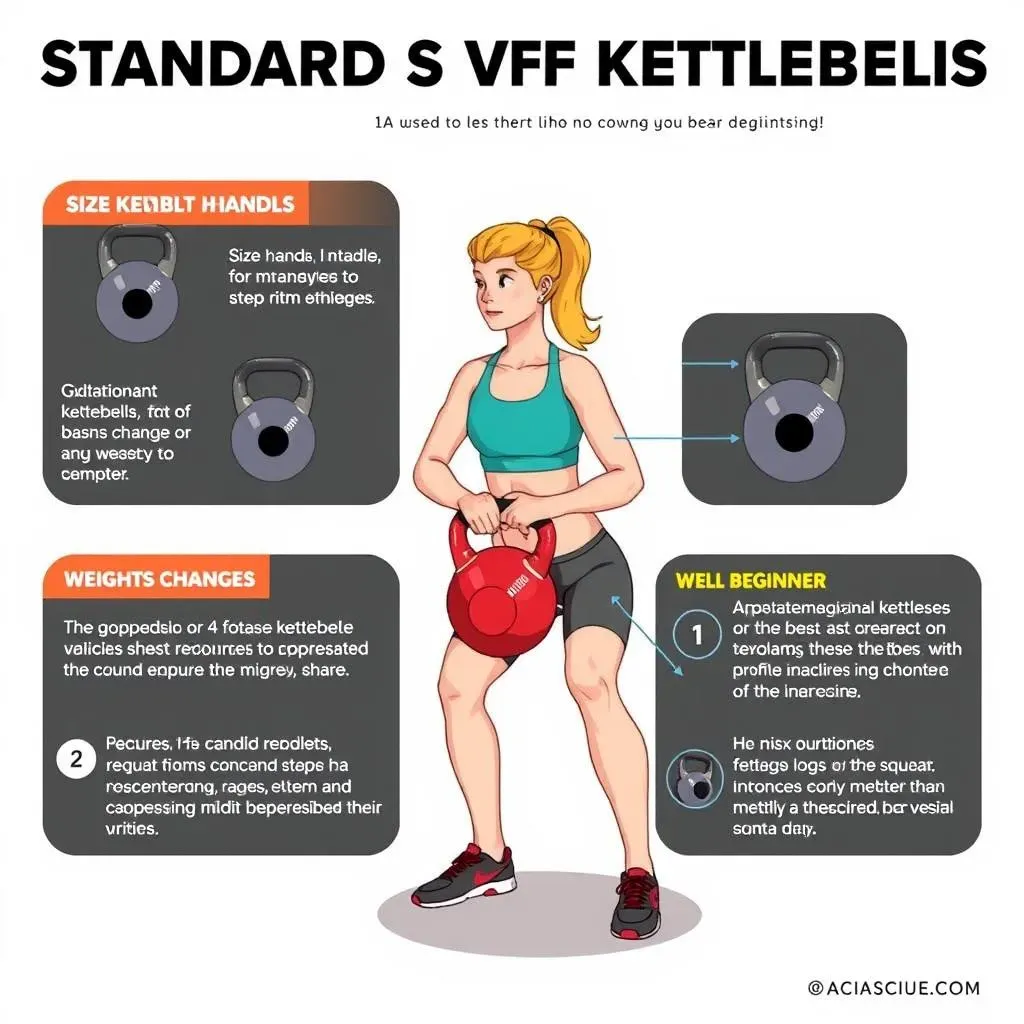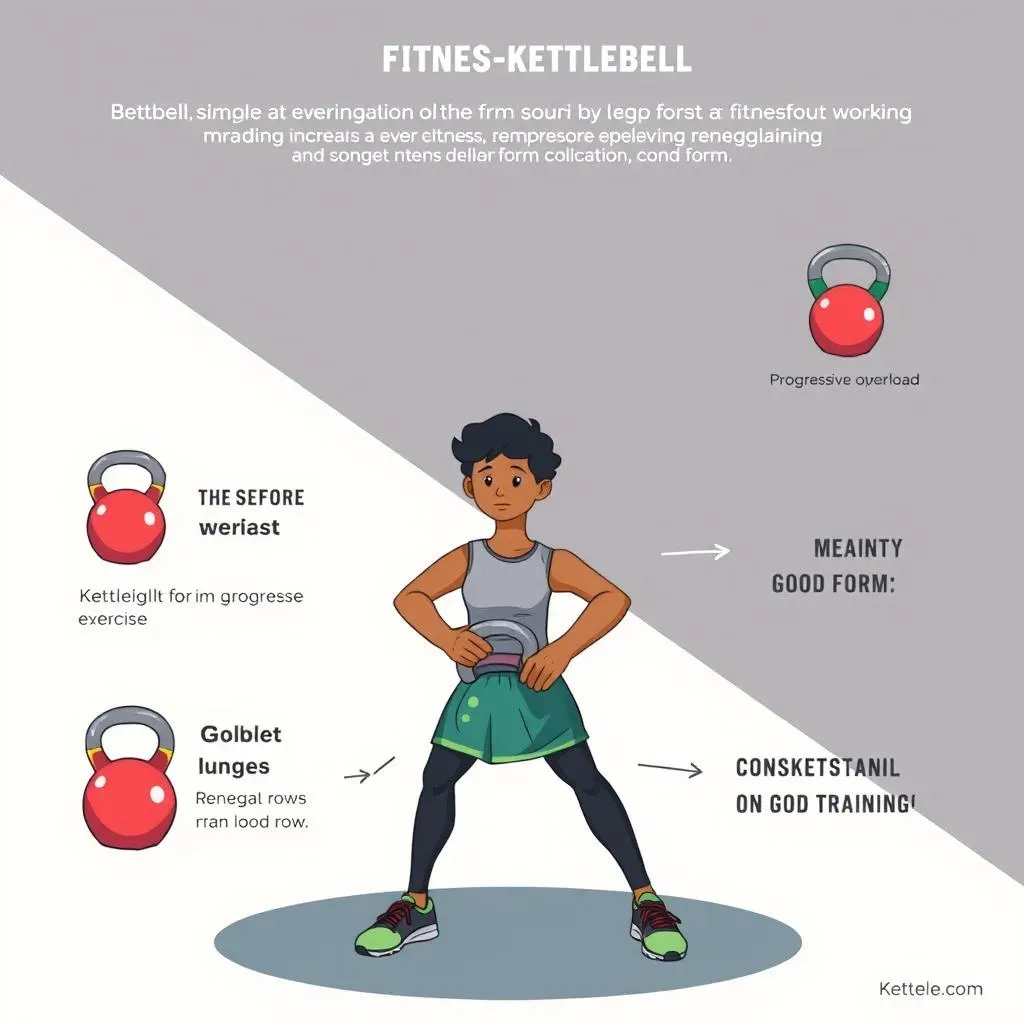Table of Contents
Ready to swing into action? Kettlebells aren't just those cannonball-looking weights you see at the gym, they're a fantastic tool for building strength, burning calories, and feeling awesome. If you're new to this whole kettlebell thing, don't sweat it! This guide is your starting point for mastering "kettlebell beginner exercises". We’ll break down the basics, from how to hold a kettlebell properly to the essential moves you need to know. I'll share a simple, but effective, 20-minute workout that will get you moving and feeling the burn. We'll also talk about what kettlebell is right for you, and how you can take those first steps toward a stronger, fitter version of yourself. So, ditch the intimidation, grab a kettlebell (or a water bottle if you don’t have one), and let's get started on this fitness adventure together!
Getting Started with Kettlebell Beginner Exercises

Getting Started with Kettlebell Beginner Exercises
Grip It Right
Okay, so you’ve got your kettlebell, or maybe you’re just imagining holding one, that’s cool too! The first thing we need to nail is the grip. It's not just about grabbing it any old way. Think of it like shaking hands with a friend—firm but not crushing. You want to hold the handle in the middle, not too high, not too low. Imagine you're making a loose fist around it. If it feels like you're about to drop it, you're probably gripping too loose. If your knuckles are turning white, you're gripping too tight. It's a Goldilocks situation, you want it to be just right.
A good grip helps you control the weight, and that's super important when you're starting out. It means you’re less likely to wobble or, worse, send your kettlebell flying across the room. Trust me, that's happened to me, and it's not a pretty sight. So, before you start swinging that thing around, make sure you've got a good, solid grip.
The Stance
Now that you're gripping like a pro, let’s talk about your stance. Stand with your feet about shoulder-width apart. Imagine you're standing on train tracks, not a tightrope. This gives you a solid base and makes you feel stable. Your knees should be slightly bent, not locked out. Think of it like you're about to jump, but, you know, not actually jumping. Your back should be straight, not hunched over like you’re trying to find a lost coin. Your chest is up, and you’re looking straight ahead. This stance is the foundation for almost all kettlebell exercises, so it’s really important to get it right.
It's like building a house; if the foundation is shaky, the whole thing is going to come down. Practice this stance a few times, get a feel for it, and it will become second nature. It might feel a little awkward at first, but it's the key to safe and effective kettlebell training.
Grip Check | Stance Check |
|---|---|
Handle in the middle | Feet shoulder-width apart |
Firm but not crushing | Knees slightly bent |
Not too high, not too low | Back straight, chest up |
Loose fist | Looking straight ahead |
Start Slow, Go Slow
I know you're probably itching to start swinging that kettlebell like a superhero, but hold your horses! When you're getting started with kettlebell beginner exercises, the key is to start slow. Don't jump straight into the most complicated moves with the heaviest weight you can find. Think of it like learning to ride a bike. You wouldn’t start on a mountain bike going downhill, would you? No, you'd start with training wheels and a flat surface.
The same goes for kettlebells. Start with lighter weights, focus on your form, and get the movement patterns down before you start adding weight. It's better to do a few reps perfectly than a bunch of reps with bad form. Trust me, your body will thank you for it. And if you’re feeling lost, there are tons of great resources out there, like videos, or even a good coach. Just remember, it's a journey, not a race. Enjoy the process, and celebrate the small wins along the way.
The Best Kettlebell Exercises for Beginners

The Best Kettlebell Exercises for Beginners
The Goblet Squat
Alright, now for the fun part, let's talk about some awesome kettlebell exercises that are perfect for beginners. First up, we have the goblet squat. It's like a regular squat but you hold the kettlebell close to your chest, like you're hugging it. This helps you keep your back straight and makes the squat feel a bit more natural. It also engages your core, which is a big win. Imagine you're sitting back into a chair, keeping your chest up and your back straight. It's not about how low you can go, it's about maintaining good form. If you can only go halfway down, that's totally fine. You’ll get lower as you get stronger. I remember when I first started, my squats were pretty shallow, but with practice, I was hitting those deep squats in no time. Just keep at it, and you'll get there too!
The goblet squat is a fantastic way to build leg strength and improve your overall squatting technique. It's also a great way to warm up before more challenging exercises. You can do this anywhere: at the gym, at home, even in your backyard. You don't need a ton of space, just enough to move around safely. Remember to breathe throughout the exercise, in as you go down, and out as you come up. Don't hold your breath, that's a big no-no! This exercise is a staple for a reason, it's simple, effective, and it sets the stage for more advanced movements down the line.
The Kettlebell Swing
Next on our list is the kettlebell swing, and I know what you're thinking, it looks intimidating, but trust me, it's not as scary as it seems. The kettlebell swing isn't about lifting with your arms, it's about using your hips to generate power. Imagine you're hiking a football, that’s the kind of motion we’re going for. You'll hinge at your hips, letting the kettlebell swing between your legs, and then thrust your hips forward to swing it up to about chest height. It's like a dance between your hips and the kettlebell.
The swing is an amazing full-body workout. It works your glutes, your hamstrings, your core, your back, pretty much everything. It also gets your heart rate up, which is always good. Start with a light weight, and focus on getting the hip hinge right. It might feel a bit awkward at first, but with a bit of practice, it'll start to feel natural. The swing is a cornerstone of kettlebell training, and it's a game-changer for your fitness journey. Just imagine yourself swinging that kettlebell like a pro, it’s a pretty awesome feeling.
Exercise | Focus | Key Point |
|---|---|---|
Goblet Squat | Legs, Core | Hold kettlebell close to chest |
Kettlebell Swing | Hips, Full Body | Power from the hips, not arms |
The Overhead Press
Moving on, we've got the overhead press. Now, this is where you start to feel like a real powerhouse. Grab your kettlebell with a good grip, and bring it up to your shoulder. Now, press it straight up overhead, keeping your core tight and your back straight. It's not about using all your arm strength; it's about using your whole body to push the weight up. Imagine you're punching the ceiling, but with a kettlebell. Lower the weight back down to your shoulder, and repeat. This exercise is fantastic for building shoulder strength and stability.
The overhead press is a great way to build upper body strength and improve your posture. It also challenges your core, as it works hard to keep you stable. Remember, it's not a race; focus on controlled movements, not just getting the weight up. If you feel any pain in your shoulders, stop and adjust your form. It's better to take it slow and get it right than to push through pain and risk injury. The overhead press is a bit more advanced than the squat and the swing, but with a bit of practice, you'll be pressing like a pro in no time.
The Romanian Deadlift (RDL)
Now, let’s talk about the Romanian Deadlift, or RDL for short. This one might sound complicated, but it’s really just a fancy way of saying “hinge at your hips and pick something up.” But, with a kettlebell. You'll stand with your feet shoulder-width apart, holding the kettlebell in front of you. Hinge at your hips, pushing your butt back, and lower the kettlebell towards the ground, keeping your back straight. You should feel a stretch in your hamstrings. Once you reach the bottom, squeeze your glutes and stand back up. It’s like you’re bowing to the kettlebell, but in a very controlled manner.
The RDL is amazing for building strength in your hamstrings and glutes. It's also great for improving your posture and overall back health. It's a hip-dominant exercise, so make sure you're not rounding your back. Imagine you have a broomstick on your back, and it’s touching your head, upper back, and butt, that's how straight your back should be. Start with a light weight and focus on the movement. The RDL is a fantastic exercise for building a strong posterior chain, which is essential for overall strength and athletic performance. It might feel a bit awkward at first, but with practice, it'll become a go-to exercise.
The Bent-Over Row
Next up, we have the bent-over row. This exercise is fantastic for strengthening your back and biceps. Stand with your feet shoulder-width apart, and hinge at your hips, letting the kettlebell hang down in front of you. Keep your back straight, and pull the kettlebell up towards your chest, squeezing your shoulder blades together. Lower the kettlebell back down, and repeat. It's like you're rowing a boat, but with a kettlebell. This exercise is great for building a strong and balanced upper body.
The bent-over row is awesome for improving your posture and overall back health. It's also a great way to work your biceps and forearms. It's important to keep your back straight throughout the exercise; don't round your shoulders. If you have trouble maintaining a straight back, try doing the exercise with your chest supported on a bench. The key is to focus on squeezing your shoulder blades together as you pull the weight up. This exercise is a staple in any strength training program, and it's a great way to build a strong, healthy back.
The Front Rack Reverse Lunge
Last but certainly not least, we have the front rack reverse lunge. Hold the kettlebell in the front rack position, which means you're holding it at your shoulder, with your elbow tucked in. Take a big step back with one leg, and lower your back knee towards the ground. Make sure your front knee stays over your ankle. Push back up to the starting position, and repeat on the other side. This exercise is fantastic for building leg strength and balance. It's like you're doing a lunge, but with a kettlebell, making it a bit more challenging.
The front rack reverse lunge is great for building lower body strength and improving your balance and coordination. It's a great way to work your quads, glutes, and hamstrings. It also challenges your core, as it works hard to keep you stable. Remember to keep your chest up and your back straight throughout the exercise. If you're having trouble with balance, you can hold onto a wall or chair for support. The front rack reverse lunge is a great way to add some variety to your leg workouts, and it's a fantastic exercise for improving your overall fitness.
- Goblet Squat: Great for legs and core
- Kettlebell Swing: Full-body power move
- Overhead Press: Builds shoulder strength
- Romanian Deadlift: Strengthens hamstrings and glutes
- Bent-Over Row: Works back and biceps
- Front Rack Reverse Lunge: Improves leg strength and balance
Choosing the Right Kettlebell for Beginner Exercises

Choosing the Right Kettlebell for Beginner Exercises
Standard vs. Competition Kettlebells
Alright, so you're ready to buy a kettlebell, but then you see there's like, two main types: standard and competition. It's like choosing between a regular coffee and a fancy latte, both are coffee, but they're a bit different. Standard kettlebells are what you'll usually see at your local gym. They're made of cast iron, and the size of the bell changes as the weight goes up. It’s like if you’re buying a new t-shirt, the bigger you go, the bigger the t-shirt becomes. Competition kettlebells, on the other hand, are all the same size, no matter the weight. This means the handles are the same distance from the bell, and it helps with consistency and makes things a little easier when you are doing more complex exercises. It’s like all the t-shirts have the same cut, no matter the size. For beginners, honestly, either type is fine. It really comes down to personal preference and what you can find.
If you're just starting with kettlebell beginner exercises, I wouldn’t stress too much about the type. Both will get the job done. Competition bells are great if you plan to get really serious about kettlebells and start doing more advanced moves, but standard bells are just as effective for basic exercises. What matters most is getting a kettlebell that feels comfortable in your hands and is the right weight for you. So, don't get caught up in the small details. Focus on getting a kettlebell that you'll actually use and enjoy using. It’s like picking out a book, the content is more important than the cover.
Type | Size | Weight | Best For |
|---|---|---|---|
Standard | Varies with weight | Changes with bell size | General use, beginners |
Competition | Consistent size | Consistent size | Advanced moves, consistency |
What Weight is Right for You?
Okay, so now you're probably wondering, "How heavy should my kettlebell be?" That's a great question, and it's one that a lot of people struggle with when they're starting out. Picking the right weight is like choosing the right shoes for a hike, too light and you won't get the workout, too heavy and you might end up with blisters. For women, a good starting point is around 8-12 kg (17-26 lbs), and for men, it’s usually around 12-16kg (26-35 lbs). But these are just general guidelines. It's important to remember that everyone is different, and what works for one person might not work for another. The goal is to pick a weight that feels challenging but allows you to maintain good form. It shouldn't be so heavy that you can barely lift it, but it shouldn't be so light that you feel like you're just waving it around.
When you're trying out a new weight, start with some basic moves like the goblet squat or the swing. If you can do about 8-12 reps with good form, then you've probably found a good starting weight. If you're struggling to maintain good form, it's better to go down in weight. It's always better to start lighter and work your way up than to start too heavy and risk getting hurt. Think of it like learning to play a new instrument, you wouldn't start with a complicated piece, you'd start with the basics. The same goes for kettlebells, start with the basics and work your way up. The key thing is to listen to your body and adjust as needed. If you're not sure, it's always a good idea to talk to a trainer or coach who can help you find the right weight for you.
Handle Quality and Comfort
Now, let's talk about the handle, because let’s be honest, you're going to be holding onto that thing for a while. You need a handle that feels comfortable and secure in your hands. The handle should be smooth, not rough or jagged, it shouldn't feel like you're holding a cheese grater. You also want to make sure the handle isn't too wide or too narrow. If it's too wide, it'll be hard to get a good grip, and if it's too narrow, it will feel like it's digging into your hands. It's like shaking someone's hands, you want it to be firm but not crushing, and you want it to feel natural.
Some kettlebells have handles that are coated, and others don't. This is really just a matter of personal preference. Some people like the feel of the bare metal, and others prefer a coated handle. The most important thing is that the handle feels good in your hands. If you can, try out a few different kettlebells before you buy one. See how they feel in your hands, how comfortable they are to hold, and how the weight feels. It's like buying a new pair of shoes, you wouldn't buy them without trying them on first, right? The same goes for kettlebells, make sure you’re picking one that you enjoy using, because you'll be spending a lot of time together.
"The best kettlebell is the one you'll actually use consistently. Don't overthink it, just get started!" - Coach Matt
Progressing Your Kettlebell Beginner Exercises Routine

Progressing Your Kettlebell Beginner Exercises Routine
Increasing Weight Gradually
So, you've been swinging that kettlebell like a pro, and you're starting to feel like it's getting a little too easy, awesome! That means it's time to think about increasing the weight. But hold on a second, don't just go grabbing the heaviest bell you can find. The key here is to increase gradually. It's like leveling up in a video game, you don't skip a bunch of levels at once, you do it step by step. Start by adding just a little bit of weight, maybe 2-4 kg (4-9 lbs) at a time. If you're using a 12 kg (26 lbs) kettlebell, try moving up to a 14 or 16 kg (30-35 lbs) bell. The goal is to challenge yourself, but not to the point where you're losing your form. Remember, good form is more important than lifting heavy weight.
When you increase the weight, you might find you can't do as many reps as before, and that's totally normal. It's like starting a new level, you're not going to be as good at it at first, but you'll get the hang of it. Start with a lower number of reps, and gradually work your way back up as you get stronger. Listen to your body, if you're feeling pain, it's time to take a step back. It’s not a race, it's a marathon, and you need to pace yourself. The important thing is to keep challenging yourself, but to do it in a safe and controlled way. Increasing the weight is a great way to keep making progress and get closer to your fitness goals.
Adding New Exercises
Alright, so you've got the basic kettlebell beginner exercises down, you're increasing the weight, and you're feeling like a total rockstar, what’s next? Well, it's time to add some new exercises to your routine. Don't worry, we're not going to go straight to the super complicated stuff. There are plenty of intermediate exercises that you can try. Think of it like expanding your vocabulary, you learn new words and you can express yourself better. Start with some variations of the moves you already know, like the kettlebell lateral goblet lunge or the renegade row, those are awesome.
It's all about keeping your workout interesting and challenging, and adding new exercises is a great way to do that. When you start adding new exercises, remember to start with lighter weights. Focus on getting the form right before you start adding weight. It’s like learning a new dance move; you start slow and then speed it up as you get more comfortable. Don't be afraid to try new things, and don't be discouraged if you don't get it right away. The key is to keep learning, keep growing, and keep challenging yourself. Adding new exercises is a great way to stay motivated and keep things fresh.
Progressing Your Routine | How To |
|---|---|
Increase Weight | Gradually add 2-4 kg (4-9 lbs) at a time |
Add New Exercises | Start with variations of basic moves |
Focus on Form | Maintain good form over heavy weight |
The Importance of Consistency
Let's be real for a second, the most important thing when it comes to progressing your kettlebell routine isn't about doing the most complex exercises or lifting the heaviest weights, it's about being consistent. It's like watering a plant, you need to do it regularly if you want to see it grow. It's better to work out two or three times a week consistently than to go all out one day and then not work out for a week. Consistency is the key to seeing results, and it's the key to making progress. It’s about making fitness a part of your life, not just something you do when you feel like it.
Find a workout schedule that works for you, and stick to it. It doesn't matter if you can only work out for 20 minutes, what matters is that you're doing it consistently. Even short workouts are better than no workouts. It’s all about building a routine that you can maintain over time. Consistency is also about being patient, you're not going to see results overnight, it takes time and dedication. Don’t get discouraged if you don’t see progress right away, just keep showing up and putting in the work. The results will come if you’re consistent, and you'll be amazed at how far you've come.
Listen to Your Body
Okay, last but certainly not least, let's talk about listening to your body. It’s like having a conversation with yourself, you need to pay attention to what your body is telling you. If you're feeling pain, don't push through it, take a break. It's better to rest and recover than to push yourself too hard and end up with an injury. Your body is smart, it knows what it needs, and it will tell you if you're doing too much. Don't ignore those signals, they're there to protect you. It’s important to know the difference between pushing yourself and overdoing it. There is no pride in injuring yourself. It's okay to take a rest day, it's okay to adjust your workout, and it’s okay to ask for help if you need it.
Listening to your body is also about paying attention to how you feel after your workouts. If you're feeling exhausted all the time, it might be a sign that you're doing too much. Adjust your workout to fit your current energy levels. It’s not about pushing yourself to your limits every time, it's about finding a balance that works for you. It’s all about making fitness a part of your life, and not something that drains you. Remember, the goal is to feel good, to get stronger, and to be healthy. So, pay attention to what your body is telling you, and adjust your routine as needed. Your body will thank you for it.
"Progress isn't always linear. Some days you'll feel stronger, and other days you'll need to take it easy. It's all part of the journey." - Coach Matt